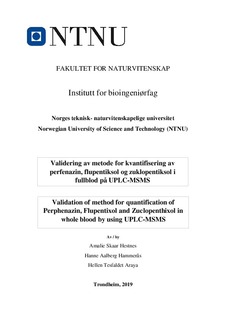| dc.description.abstract | I dette bachelorprosjektet ble det utført validering av en ny metode for analyttene perfenazin, flupentiksol og zuklopentiksol i fullblod. Metoden i fullblod benyttes for kvantifisering av analyttene i obduksjonsprøver. Metodene for analyttene perfenazin, flupentiksol og zuklopentiksol ble kalt for LDN (lavdose nevroleptika). LDN-metodene ved Avdeling for Klinisk Farmakologi (AKF) benytter seg i dag av proteinfelling for serum og væske-væske ekstraksjon for fullblodsprøver.
Hensikten med metodevalideringen var å undersøke om væske-væske ekstraksjon kan erstattes med proteinfelling, da overgang til proteinfelling som prøveopparbeidelse vil føre til økt effektivitet og mindre bruk av toksiske løsemidler. I tillegg ble det undersøkt om en kan benytte standardrekke med serum for kvantifisering av fullblodsprøver, eller om det måtte bli benyttet en egen standardrekke med fullblod.
For å undersøke dette ble det analysert flere serier med standarder og kontroller i serum og blod. Resultatene ble vurdert ut ifra parametere som presisjon, riktighet og signal/støy-forhold. Standardrekken i serum ble sjekket ut ifra gitte kriterier, om den kunne benyttes for kvantifisering av fullblod, og det ble bestemt en nedre kvantifiseringsgrense. I tillegg ble holdbarheten til prøver benyttet i metoden undersøkt.
Resultatene viste at kriteriene for repeterbarhet, reproduserbarhet og %Bias ble oppfylt, og metodens presisjon og riktighet ble godkjent. Signal/støy-forholdene som ble vurdert var innenfor kriteriene på ≥30 for kvantifiseringsionet og ≥10 for kvalifiseringsionet, noe som tilsier lav interferens. Analysen av standardrekkene i serum viste at én verdi var utenfor kriteriet på 20% fra teoretisk verdi, men i samhandling med medisinsk ansvarlig ved AFK ble det bestemt at standardrekken i serum ble godkjent til kvantifisering av fullblodsprøver. Nedre kvantifiseringsgrense ble bestemt til å være STD 2 med konsentasjonsnivåene 1,0 nmol for Perfenain og Flupentiksol og 5,0 nmol for Zuklopentiksol. Holdbarhetsanalysen viste god holdbarhet opptil én dag etter prøveopparbeidelsen, og at holdbarheten ved tin/frys var tilfredsstillende.
På grunnlag av gode resultater ble det konkludert at den nye analysemetoden for LDN i fullblod ble godkjent. Dermed vil proteinfelling kunne erstatte væske-væske ekstraksjon som prøveopparbeidelse for fullblodsprøver. I tillegg ble standardkurver fra serum godkjent for bruk i metoden. | |
| dc.description.abstract | In this bachelor project, a new method for the analytes Perphenazine, Flupentixol and Zuclopenthixol in whole blood was validated. The whole blood method was used to quantify the analytes in autopsy specimen. The methods were used for quantification of Perphenazine, Flupentixol and Zuclopenthixol is called LDN (low dose neuroleptics). At the Department of Clinical Pharmacology (AKF), the currently used methods for LDN, utilizes both protein precipitation for serum samples and liquid-liquid extraction for whole blood samples.
The aim of this project was to investigate whether liquid-liquid extraction could be replaced by protein precipitation. The transition to protein precipitation, as sample preparation for whole blood will lead to increased efficiency and less use of toxic solvents. Furthermore, the possibility of using standard series of serum for quantification of whole blood samples would be examined, or whether a separate standard series of whole blood must be utilized.
To examine this, several series of standards and controls were analyzed in serum and blood. The results were evaluated based on parameters such as precision, accuracy and signal/noise-ratio. The standard series in serum were checked based on a given criteria, whether it could be used for whole blood quantification and a lower quantification limit was determined. In addition, the shelf life of samples used in the method were examined.
The results were showing that the criteria for repeatability, reproducibility and %Bias were met, and the precision and accuracy of the method were approved. The signal-to-noise ratios that were assessed were within the criteria of ≥30 for the quantification ion and ≥10 for the qualification ion, indicating low interference. The analysis of the standard series in serum was showing that one value was beyond the 20% criterion from theoretical value, but in a conversation with the medical officer at AFK, it was determined that the standard serum series could be approved for quantification of whole blood samples. The lower limit of quantification was determined to be STD 2 with the concentration levels of 1.0 nmol for Perphenazine and Flupentixol and 5.0 nmol for Zuclopenthixol. The durability analysis was showing good durability up to one day after the sample preparation, and the shelf life of thaw/freeze was satisfactory.
Based on the good results that were obtained, it was concluded that the new analysis method for LDN in whole blood was approved. Thus, protein precipitation could replace liquid-liquid extraction as sample preparation for whole blood samples. In addition, standard curves from serum could be approved for use in the method. | |
